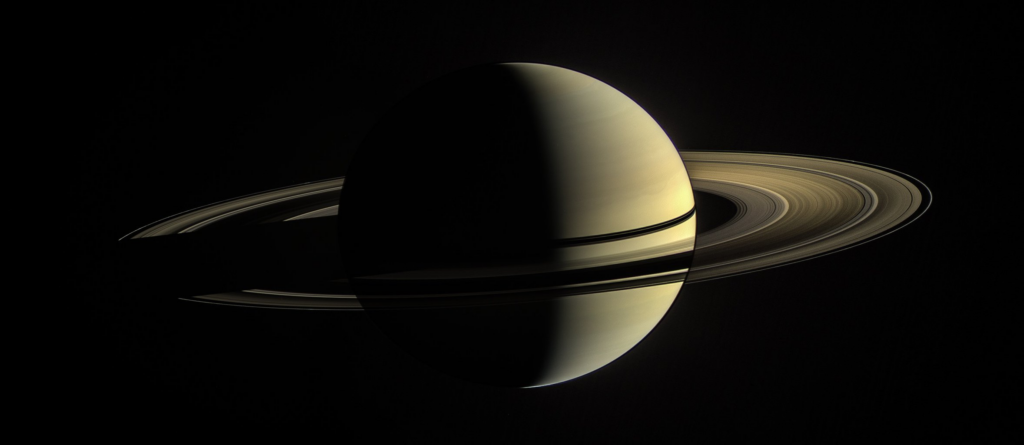September gives us an opportunity to see two planets at opposition – Saturn (September 8) and Neptune (September 21), and both of them will be visible all night. You can easily find Saturn in the sky with the naked eye, but to see Neptune you will need a small telescope or astronomical binoculars. Although Saturn’s opposition occurs almost every year, this one will be somewhat special…

Observation of the planets in opposition
For us, as observers from Earth, all the other planets in the Solar system can be divided into 2 groups: inner and outer. The inner planets are those whose orbits are inside the Earth’s orbit, that is, Mercury and Venus. Other 5 planets – from Mars to Neptune – belong to the outer ones.
The conditions for observing the inner and outer planets are significantly different. In particular, the best configuration for observing outer bodies is one in which the Earth is between the Sun and this body. This mutual arrangement is called opposition. It is near oppositions that the outer planets are the brightest and have the largest angular dimensions.
In addition, since the planet is opposite to the Sun relative to us at this time, it will be 100% illuminated and can be observed all night long. Therefore, the opposition of the planet is the best time to observe it. However, it should be noted that for several days before and after the opposition, you will not notice significant differences in the appearance of the planet.
It is noteworthy that the moment of opposition usually does not exactly coincide with the moment when the planet is at its shortest distance from us, which is due to the ellipticity of the orbits. For example, this year, Saturn’s opposition will take place on September 8 at 04:35 UTC, but it will be closest to us on the same day at 07:12 UTC.
Are all planetary oppositions the same?
Oppositions of the giant planets occur almost every year. But does this mean that each time a certain planet will look the same at opposition? This is definitely not the case for Saturn!
The most noticeable change is in the appearance of Saturn’s rings. Like the Earth’s axis, the axis of this planet is not perpendicular to the plane of its orbit. The equator of the gas giant and the plane of its rings are tilted to the plane of its orbit at an angle of 27°. During the Saturnian year, the rings maintain their orientation relative to distant stars, but from Earth we see that their tilt gradually changes. The rings have been “closing” for the last 7 years, and now their tilt toward Earth is only 3.3°, and the next year the rings will “disappear” for a while.

In addition to Saturn’s appearance, its angular dimensions also change from one opposition to another. The fact is that both Earth and Saturn move around the Sun in somewhat elongated elliptical orbits. The distances from Saturn to the Sun at perihelion (when the planet is closest to the Sun) and at aphelion (the most distant point) differ by almost 12%. Accordingly, for an Earth-based observer, the angular dimensions of the planet in different oppositions vary by almost 13%: from 41.7″ to 47″ – including the rings.

Of all the giant planets, Saturn’s otbit is the most elongated, and the difference in apparent size and brightness during oppositions is quite significant. Mars’ oppositions are even more different – its orbit is even more elongated than Saturn’s, and is the most elongated of all the outer planets. Every 15-17 years, the so-called great opposition occurs, when Mars reaches the magnitude of -2.9m, becoming brighter than Jupiter.
Neptune’s orbit is nearly circular, so the distance to us at oppositions is almost the same every year. Being 30 times farther from the Sun than Earth, it is the only large planet that cannot be observed with the naked eye even at opposition.
Features of Saturn opposition this year
The opposition of the outer planets is not such a rare phenomenon. Saturn makes a full revolution around the Sun in 29.46 years, during which the Earth catches up and overtakes it 29 times. Between two adjacent oppositions there is about 1 year and 13 days, so sometimes there are years during which there is no opposition at all. The last time this happened was in 2004: one opposition occurred on December 31, 2003, and the next one – on January 13, 2005.
This year, during the opposition on September 8, Saturn will be in the constellation of Aquarius. With a magnitude of +0.6m, the planet will be the brightest object in the constellation, easily spotted in the night sky.
The rings are still visible through the telescope from the northern direction (the side of the rings closest to us is below the equator), but the current opposition is the last one before the rings turn edgewise and become inaccessible for observation. This will happen at the end of March, but, unfortunately, “naked” Saturn will be unavailable for observations: the planet will be too close to the Sun at this time.
At the next opposition, on September 20, 2025, we will already see the rings from the southern direction. Thus, the current opposition is the last chance to see Saturn’s rings in this orientation. After that, during the next 7 oppositions, the visibility of the planet’s southern hemisphere will improve, and its rings will gradually open, allowing observers to see the Cassini division.
While observing Saturn at opposition through a telescope, pay attention to its moons. Of the 146 currently known moons, one may usually see up to 5 of them throuth amateur telescope. The largest and brightest of them is Titan. But with an average instrument you can also see Rhea, Iapetus, Dione and Tethys.
The Seeliger Effect: why Saturn’s rings get brighter during opposition
In 1887, Hugo von Seeliger, while observing Saturn during the opposition, noticed an interesting effect: the rings seemed somewhat brighter than usual. It was already known then that the rings are not monolithic, but consist of individual small particles. Seeliger himself explained the effect as follows: the pores and depressions on the surface of the pebbles that make up the rings do not cast shadows during opposition, since the light source is located directly behind the observer. All the light reflected by the ring particles is directed right at us.
In 1956, Bruce Hapke refined the physics of the Seeliger effect by adding a mechanism of coherent backscatter: the light reflects many times by the countless tiny dust particles of the rings, so to speak, adds up – interferes.
While the surface brightness of Saturn’s rings and the planet’s disk are usually about the same, during opposition the rings somewhat dominate. This is a “subtle” effect that is easier to notice in photographs than during visual observations. The Seeliger effect is observed not only on the night of opposition, but also for about 3 days before and after the event.
What to expect from Neptune’s opposition and how to observe it
Neptune moves across the celestial sphere very slowly; a year on this planet lasts about 165 Earth years. Therefore, 1 year and 2 days pass between adjacent oppositions. This year, on September 20 at 22:43 UTC, Neptune will be in opposition, located in the constellation Pisces. Formally, near this date, we will have the best conditions for observing this distant planet.
Neptune is the only large planet in the Solar System that cannot be seen with the naked eye. Even during opposition, its magnitude is only 7.8m, that is, it’s 5 times fainter than the faintest stars that can be seen in the perfect sky.
In fact, the visibility conditions of Neptune vary very little: its brightness fluctuates within 0.2m, and its apparent angular size is 2.2” – 2.4”. You will not notice much difference between the appearance of Neptune on the days of opposition and outside of them. When choosing the best time for observations, it is worth paying more attention to the atmosphere conditions, the altitude of the planet above the horizon and the angular distance to the Moon: the larger, the better.
Through an amateur telescope, Neptune looks like a tiny disk of a barely noticeable blue hue. It differs from the stars by the lack of “sparkling”. The largest moon of Neptune, Triton, with a brightness of 13.9m, might be accessible to sufficiently powerful amateur instruments.
There in no need to worry if you are unable to catch the planet on the day of opposition! For several weeks, the observation conditions will remain no less favorable.


